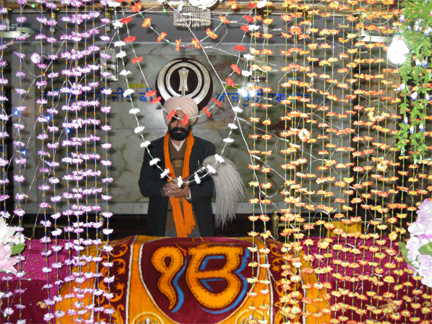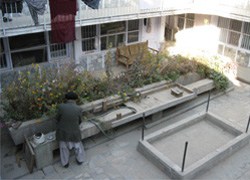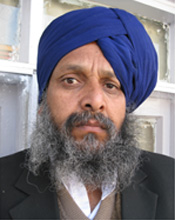Afghanistan - post elections
Sikhs struggle for recognition in the Islamic republic
by Tony Cross
Article published on the 2009-11-14 Latest update 2009-11-15 12:03 TU

Daya Singh Anjaan, spokesperson of the Afghan Hindu-Sikh Society, in the Dharamsal temple
(Photo: Tony Cross)
On a quiet but dusty Kabul street, turbaned men stroll and children in topknots play. These are rare sights in the Afghan capital. They are Sikhs, living around the Dharamsal temple, where they observe their faith.
Sikhs are a tiny minority of the country’s estimated 31 million population - about 3,000 according to their leaders, scattered across the country. There are even fewer Hindus, they say, putting their number at about 1,000.
Over three decades of war most of their community have left for India, Canada and other destinations. As their numbers shrank, so did their weight in Afghan life.
Until the civil war of the 1990s, Hindus, Sikhs and Jews controlled money markets in major towns, according to author and journalist Ahmed Rashid in his book Taliban. Afghan kings borrowed money off them when they went to war.
Now the community is impoverished, according to Daya Singh Anjaan, the spokesperson of the Afghan Hindu-Sikh Society. Once they had businesses, now they struggle to make ends meet.
Muslim Afghans see no difference between Hindus and Sikhs, referring to them all as Hindus. There are no elected MPs from either group. While traditional migrants, known as Kuchis, have ten reserved seats, no parliamentary posts are put aside for Sikhs and Hindus.
President Hamid Karzai has appointed one senator to represent both communities. He is Awtar Singh, a tall man wearing a blue turban, who took his seat six months ago. He replaced another representative, who, he says, was not doing the job.
Does it worry him that the country he lives in declares itself to be an Islamic republic?
“No, that’s not actually a problem,” he says. “Muslims and Sikhs have communication. We are respecting Islam and the Muslims are respecting us. Before out forefathers had good relations and we have good relations.”
But the Sikhs have had their problems. When the Taliban ruled the country before the 2001 invasion, they ordered Hindus and Sikhs to wear yellow tags, sparking alarm in the community and abroad, and they ordered Sikh women to wear the veil.
But they were not really worse than the anti-Communist mujahedin governments which preceded them, says Daya Singh Anjaan.
The date that sticks in the Sikhs’ minds is 1992. That year the country had its first mujahedin president and a Hindu mob destroyed the Babri mosque in the Indian city of Ayodhya. In Kabul the Sikh temple was burned down as a reprisal. Then war erupted between mujahedin factions.
Report: Sikhs in Kabul
Rashid, too, sees the date as the end of centuries of inter-ethnic harmony and religious tolerance.
“The civil war has divided Islamic sects and ethnic groups in a way that before was unimaginable to ordinary Afghans,” he writes.
As a senator, Awtar Singh says that he is campaigning for the return of rights that the Sikhs used to have. Under the Soviet-backed President, Najibullah, many Sikhs had good jobs, he says.
“We had many people working in ministries and many schools and many colleges … This is our right that we don’t have now.”
Sikh monuments have been destroyed in the war and, in one case, turned into a mausoleum for a dead president, according to Daya Singh.
Further problems came when a group of people built houses near the Kabul ghat, the place where the Sikhs traditionally cremate their dead. The newcomers demanded that the practise end and that has created tension.
And Sikhs living in Ghazni province were harassed by Taliban insurgents before the rebels lost ground in the area.
But what annoys Daya Singh most is the lack of official recognition that Sikhs and Hindus exist. A new national anthem mentions all Afghanistan’s ethnic groups, except the Hindus and the Sikhs. The same goes for speeches at official ceremonies.
“Why? We are from Afghanistan. If we have done something bad then we will leave this country. We haven’t done anything wrong in this country.”







